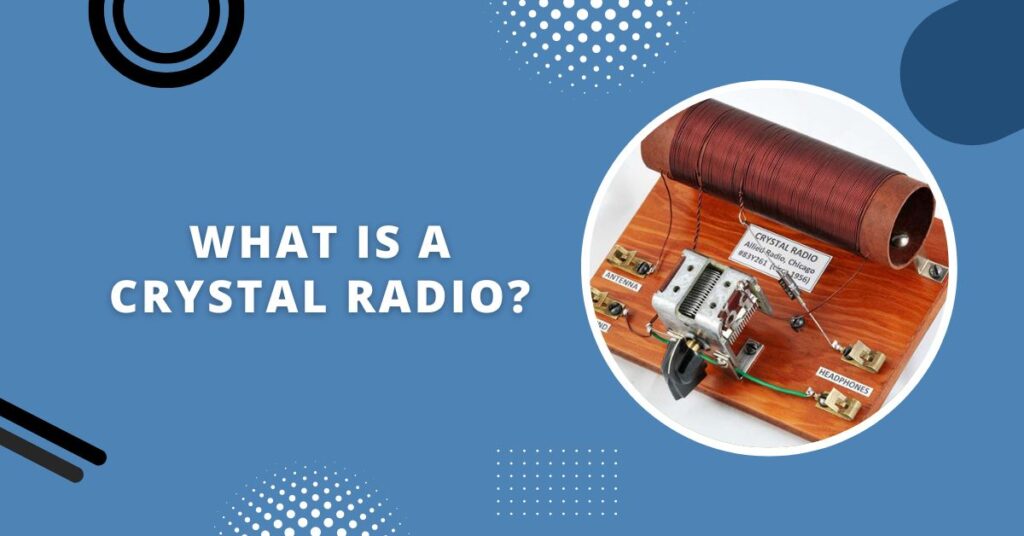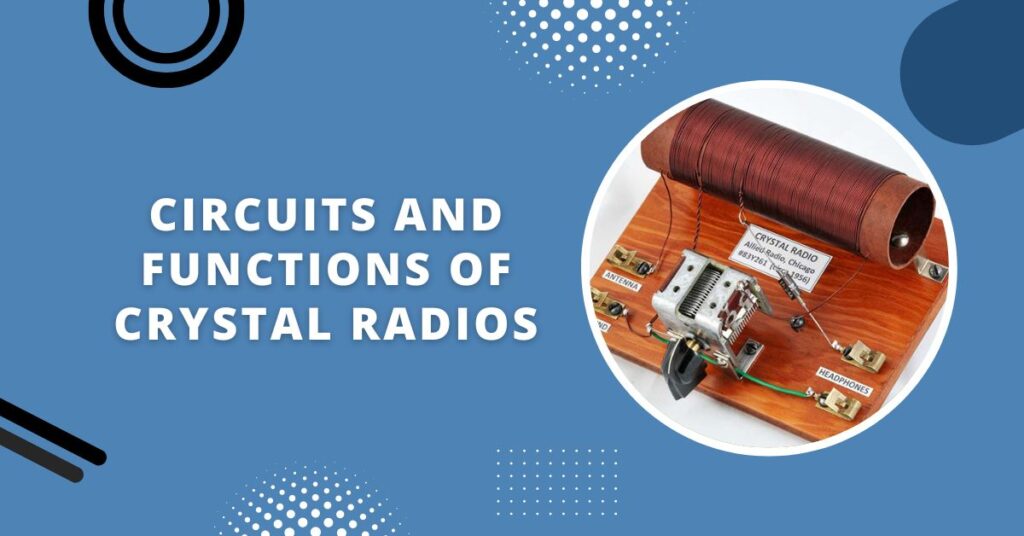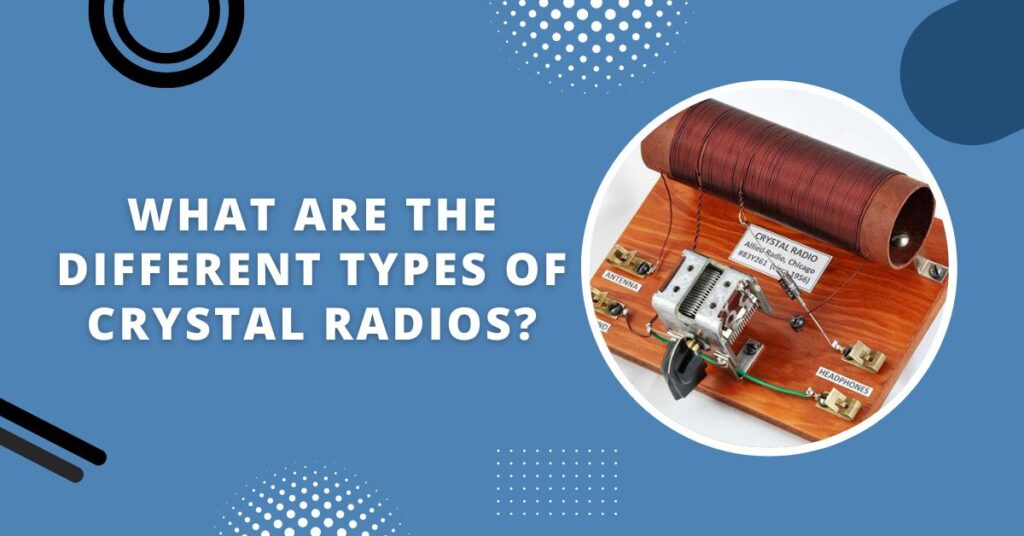Last updated on May 4th, 2023 at 08:55 am
Learn how do crystal radios work. and how they are able to pick up AM radio signals without the use of batteries or power sources. Discover the role of the crystal detector, tuning coils, and antennas in the functioning of a crystal radio.
Introduction
Radio receivers that use the power of radio waves rather than an external power source to create sound are known as crystal radios, also known as crystal sets or cat’s whisker radios. As one of the first types of radios to be developed, they were widely used in the early 20th century.
A crystal radio consists of four basic components: an antenna, a tuning coil, a crystal detector, and headphones. The antenna captures radio waves and transmits them to the tuning coil, which selects a specific station.
An audible sound is then produced by the crystal detector, which transmits the electrical signal to the headphones. This article explains the science behind crystal radios, and how they are able to receive AM radio signals without the use of batteries or power sources.
What Is a Crystal Radio?

As one of the first types of radio receivers to be developed and widely used in the early 20th century, crystal radios utilize the power of radio waves rather than external power sources to create sound. A crystal radio is comprised of an antenna, a tuning coil, a crystal detector, and a pair of headphones.
Tunning Coil:
It is the antenna’s responsibility to capture radio waves and transmit them to the tuning coil. This coil, also known as a resonant circuit, is responsible for selecting a particular radio station. The radio waves are then sent to the crystal detector, also known as a crystal rectifier, which converts the electrical signal into an audible sound. These sounds are then sent to the headphones.
Crystal Detector:
In crystal radios, a crystal detector is the core component that rectifies radio waves using a small piece of semiconducting material, such as Galena, which is a mineral. The crystal detector works by allowing the current to flow in one direction while blocking it in the other. As a result, the crystal detector only allows the positive part of the radio wave to pass through, resulting in sound.
Build:
Crystal radio was popular in the early 20th century because of its simplicity and affordability. It was commonly constructed by individuals using common household items such as wire, nails, and glass jars. Furthermore, they did not require a power source, so they were ideal for rural areas without electricity.
AM Radio
The crystal radio, however, has some limitations, including the inability to pick up AM radio stations, the sensitivity, and selectivity, and the sound quality being inferior to those of more recent radios. Although crystal radios are a part of radio history, they continue to hold a special place in the hearts of many radio enthusiasts.
Final Words
Crystal radios are types of radio receivers that create sound by utilizing the power of radio waves without the need for external power sources. Originally, crystal radios were popular because of their simplicity and low cost.
However, more advanced technologies have replaced them in recent years. They comprise an antenna, a tuning coil, a crystal detector, and headphones.
How Do Crystal Radios Work?

A crystal radio makes use of an electrical current to create a magnetic field, which in turn creates sound waves. The amplified sound waves are then transmitted through the speaker to the listener.
The crystal radio uses electricity in the air as its power source, so batteries or a power source are not necessary. It is made of a crystal, wire coil, and cardboard.
Step: 1
The first step in building a crystal radio is to find a crystal that creates an electrical current. Quartz crystals are the most common type of crystal. When you have the crystal, you need to form a coil of wire. The wire can be wrapped around a piece of cardboard or another object to accomplish this.
Step: 2
As the wire is soldered to the crystal, you must then connect the other end of the wire to the ground. This is done by soldering the wire to the crystal. The ground can be any conductive material, such as a metal rod or a piece of metal foil.
Step: 3
It is crucial that the wire is connected to the antenna of the radio after it has been connected to the ground. The radio can be an AM/FM radio, a shortwave radio, or a CB radio.
Step: 4
It is imperative that you tune the radio to the right frequency after connecting the wire to the radio. The frequency is the number of waves produced per second by the radio.
Step: 5
It is important to adjust the coil of wire once the radio has been tuned to the right frequency in order to get a clear sound. To do so, move the coil closer to the crystal or further away from it, depending on your preference.
Final words
Your crystal radio can be enjoyed once the sound is clear.
Circuits and functions of crystal radios

A crystal radio is a device that, instead of relying on an external power source to generate sound, makes use of the natural energy of radio waves to create sound. Crystal radios are also known as crystal sets or cat’s whisker radios.
One of the earliest forms of radios, they were widely used in rural areas where electricity was not yet widely available in the early 20th century, particularly in rural areas. In order to function properly, a crystal radio requires several important circuits and components that perform specific functions.
1. Antenna Circuit:
There are numerous types of antennas that can capture radio waves. These structures may be simple wires or more complex structures such as long wires or dipoles. In order for the radio to process electromagnetic waves, the antenna circuit must convert those waves into electrical energy.
2. Tuning Circuit:
The tuning circuit, also known as the resonant circuit, is used to selectively tune into a specific radio station. It comprises an inductor, a coil of wire, and a capacitor. Together, they form a resonant circuit that resonates at the frequency of the desired radio station, effectively filtering out other stations.
3. Crystal Detector Circuit:
The radio waves are then passed on to the crystal detector, which is a small piece of semiconducting material such as a mineral called Galena. The crystal detector, also known as a cat’s whisker detector, uses the rectifying properties of the crystal to convert the radio waves into an electrical signal that can be further processed.
4. Audio Circuit:
The electrical signal is then sent to the headphones, where it is converted into an audible sound. The audio circuit amplifies the weak electrical signal coming from the crystal detector to a level that can be heard through the headphones.
5. Ground Circuit:
The ground circuit is used to complete the circuit and provide a return path for the current. It is usually connected to the antenna circuit and is used to create a voltage difference between the antenna and the ground.
6. Tuning Capacitor:
The tuning capacitor is a variable capacitor that is used to fine-tune the frequency of the radio station being received. It allows the radio to tune into different stations by adjusting the capacitance of the circuit.
Final Words:
Crystal radios are a unique type of radio receiver that utilizes the natural energy of radio waves to create sound without an external power source. They consist of several key circuits, including the antenna circuit, tuning circuit, crystal detector circuit, audio circuit, ground circuit, and tuning capacitor.
Each of these components plays a vital role in the functioning of the radio, allowing it to capture and process radio waves, and produce an audible sound that can be heard through headphones.
Troubleshooting and High-Performance Crystal Radio
A crystal radio can be troubleshot by keeping a few things in mind.
What do they sound like?
There is no need to use batteries or electricity to produce sound with crystal radios. They produce sound by utilizing the power of the radio waves themselves. Because of this, they are easy to operate and extremely portable, as they can be used anywhere there is a strong signal.
According to the quality of the components and the strength of the signal used, crystal radios can produce varying sound quality. They usually have a warm, natural sound, and can be picked up from a wide range of frequencies. This makes them ideal for listening to music and picking up radio signals in general.
What are the different types of crystal radios?
As a type of radio receiver that uses the power of radio waves rather than an external power source to create sound, crystal radios are sometimes referred to as crystal sets or cat’s whisker radios.

In the early 20th century, they were widely used as one of the first types of radios developed. In spite of the fact that the basic design of crystal radios remains the same, different types of crystal radios have been developed over time. These include:
1. Simple Crystal Radio:
There are several types of the crystal radio, but the most basic ones are also known as “one-tube” or “two-tube” radios. The basic crystal radio includes a crystal detector, tuning coil, antenna, and headphones. As one of the simplest and most basic types of crystal radios, it is often used as an educational tool to demonstrate radio technology principles.
2. Regenerative Crystal Radio:
With a regenerative crystal radio, a regenerative feedback circuit is added to the basic design, which enhances the radio’s sensitivity and selectivity by amplifying the weak electrical signal coming from the crystal detector.
3. Superheterodyne Crystal Radio:
Crystal radios of this type utilize superheterodyne circuits, an advanced circuit that enhances the radio’s sensitivity and selectivity. By converting the incoming radio frequency signal to a lower, intermediate frequency, the superheterodyne circuit makes tuning and filtering easier.
4. Crystal Diode Radio:
Unlike traditional crystal radios, this type uses a crystal diode as opposed to a crystal detector. A crystal diode is a semiconductor device that is more accurate and reliable than a crystal detector, making it more sensitive and selective than traditional crystal radios.
5. Transistor Crystal Radio:
The transistor radio was developed in the 1950s and became very popular due to its smaller size and portability compared to traditional tube radios.
Final Words:
A crystal radio has been developed in a variety of forms over the years, although its basic design remains the same. Among these are simple crystal radios, regenerative crystal radios, superheterodyne crystal radios, crystal diode radios, and transistor crystal radios. Each type has its own unique features and characteristics, as well as different levels of sensitivity, selectivity, and performance.
How do you make your own crystal radio?

Building your own crystal radio is a fun and educational project that will allow you to gain an understanding of the principles of radio technology. Here is a step-by-step guide on how to build your own crystal radio:
1. Gather materials:
Crystal radios require a few basic components, including wire coils, capacitors, crystal detectors, headphones, and antennas, which can be obtained from electronics suppliers or scavenged from old electronics.
2. Build the antenna:
As the first component in the radio transmission system, the antenna is responsible for capturing the radio waves. You can build a simple antenna using a long piece of wire. The wire should at least be as long as the wavelength of the radio station you wish to listen to.
3. Build the tuning coil:
This coil of wire, also known as the resonant circuit, is used to select a specific radio station. You must make the tuning coil with coiling wire. The number of turns and the size of the coil is determined by the radio station to be listened to.
4. Install the crystal detector:
You can install the crystal detector by soldering it to the ends of the coil wire. It converts the electrical signal into an audible signal. The crystal detector can also be referred to as a crystal rectifier.
5. Connect the headphones:
You can connect the headphones by soldering them to the crystal detector, which then converts the electrical signal into an audible signal.
6. Connect the capacitor:
By adjusting the capacitor, the radio can tune into different radio stations by fine-tuning the frequency of the signal.
7. Adjust the tuning:
The tuning can be adjusted by moving the crystal detector’s cat’s whisker across the crystal surface. Listen for a loud, clear station, and fine-tune the tuning coil as necessary.
Final Words
It is important to note that building a crystal radio requires some basic electronic skills, including soldering and circuit understanding. In addition, it is important to take precautions whenever working with electronic components.
Why are crystal radios so popular?
This type of radio is very popular because it’s so easy to build. Just a piece of quartz crystal and some wire are all you’ll need.
Their low power makes them perfect for portable applications since they can be powered by a small battery, or even your own body (via a “body capacitor”).
Additionally, they are great for applications where power isn’t always available, as they are highly durable and can withstand a lot of abuse.
What are the main components of a crystal radio?
There are several types of crystal radio, but a crystal radio is a specific type of radio that uses a crystal as a power source to control the flow of electricity. A crystal radio uses a crystal to create an electrical circuit that is capable of amplifying the radio waves. A crystal radio is a straightforward device and only a few components are needed to build it.
There are four main components in the crystal radio: the crystal, the inductor, the capacitor, and the resistor. The crystal is responsible for creating the electrical circuit that will amplify the signal from the radio waves.
It is composed of an inductor, a capacitor, and a resistor, which are all used in order to produce the magnetic field that amplifies the radio waves.
FAQs
Does a crystal radio need a battery?
In contrast to batteries or power sources, crystal radio receivers require no batteries or power sources other than the power that they receive from radio waves using their long outdoor wire antennas.
How do quartz crystals work in radio?
A quartz crystal’s frequency is determined by its precise physical dimensions. When a voltage is applied to it, the crystal will bend at its resonant frequency. The oscillations would normally decay and eventually cease due to internal losses within the crystal.
How far can a crystal radio reach?
The AM broadcast stations, however, can only be received within 25 miles, even though radiotelegraphy signals could be received hundreds of miles during the wireless telegraphy era, and crystal receivers were even used for transoceanic communication during those days.
Why does a crystal radio need a ground?
Relatively speaking, long-line antennas and the other connection ground are a good way to intercept reasonably high RF power, which is why most crystal radios use them.
Can you use any diode for crystal radio?
A diode with a forward voltage (Vf) of 225mV to 250mV works best with crystal radios. The diode must have a Vf of less than 300mV to work. A digital multimeter with a diode check feature will help you check the Vf.
How does a crystal resonator work?
In order to sustain oscillation, the crystal oscillator circuit takes voltage signals from quartz resonators, amplifies them, and feeds them back to the resonators. By measuring the rate at which quartz expands and contracts, one can determine its resonant frequency.
Is diode and crystal diode the same?
In radio kits, diodes are used as rectifiers because they supply current only in one direction. Early diodes were crystal diodes. In this diode, a very fine wire, namely the cat’s whisker, was used to feed a weak signal into the crystal material.
How does a crystal diode work as a switch?
As soon as a voltage exceeds a specified value, the diode’s resistance increases, leading to an open switch as result. Diodes are forward-biased when the voltage applied is below the reference voltage, so they act as closed switches when the voltage applied is below the reference voltage.
Conclusion
Throughout this blog, we will explore how crystal radio works in order to deliver that classic sound and how it works. We hope you enjoyed this blog on the history behind crystal radios and learned something new about the technology behind these old radios. You can reach out to us at any time at _ if you have any other questions about this or other topics. We’re always glad to help!
